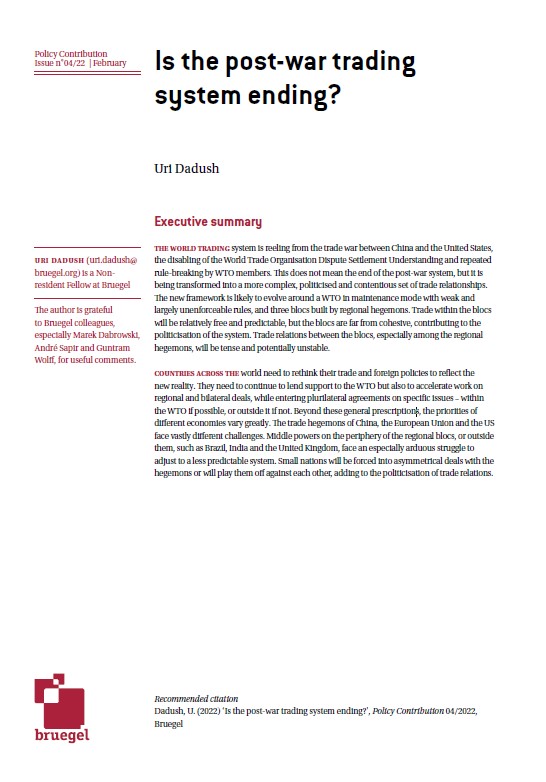Blog Post
The Mexican automotive industry and Trump’s USA
Trade with Mexico is a controversial topic for the new US administration. And the automotive sector is emblematic of Trump’s promise to bring manufacturing jobs back to the USA. But a look at the numbers reveals risks in any shake-up of cross-border trade. 22% of US automotive exports to Mexico are later reimported as part of cars “made in Mexico”. And disrupting production chains could have repercussions around the world.
The border with Mexico has repeatedly been in the crosshairs of Trump’s tweets. The USA’s southern neighbour is a major source of worry for the new administration, not only on immigration but also trade. And it was only a matter of time before the automotive industry found itself in the centre of the argument, given its central role for the Mexican economy and bilateral trade relations with the US.
Indeed, Trump won the presidential election partly thanks to a surprisingly strong result in the Rust Belt states, which have a high share of employment in the automotive industry. Combine this with Trump’s clear fondness for manufacturing industries, and his (rather dubious) conviction that renegotiating trade deals will “bring back” highly-paid skilled jobs, then it is clear that the automotive sector will be a key area of contention between the USA and Mexico.
But does the economic reality back up the rhetoric? To gauge the magnitude of the underlying economic forces at play, it’s worth looking at recent trends in the automotive industry in North America. How important is the sector for the Mexican economy and bilateral trade relations between US and Mexico? And what would be the impact of any trade restrictions or policies that actively disrupt current trade flows?
The automotive industry plays a central role in Mexico’s economy and trade
At the time when the North American Free Trade Agreement (NAFTA) entered into force, the automotive industry accounted for 1.9 percent of Mexican GDP. In 2015, this share had increased to 3.4 percent, according to the Mexican Statistical Institute (INEGI).
The importance of the sector is also reflected in employment statistics. As of December 2015, 875,382 people were directly employed in the automotive industry, 10 percent in the manufacture of vehicles and trucks and 90 percent in the auto parts sector. In terms of total manufacturing, automotive production represented 18.3 percent of total manufacturing production (in 2015) and 14.4 percent of overall manufacturing employment (according to the 2014 economic census).
In light of these developments, Mexico became the world’s 7th largest vehicle producer and the most important in Latin America. More than 80 percent of the production of vehicles is devoted to export, which makes it the world’s 4th largest automobile exporter, behind Germany, Japan, and South Korea. Data collected by the Mexican Automobile Industry Association show that 70.2% of Mexican vehicle exports went to the US (in Q1 of 2015). Mexico is now the USA’s 2nd largest vehicle supplier after Canada, take the spot that Japan had occupied since 1970.
According to the Center for Automotive research, Mexico has captured 9 of the last 11 announced new assembly plants for the continent since 2011. In a report published in July 2016, it is argued that much of the occurred (and foreseen) reduction in the USA’s share of North American vehicle production of is mainly due to new production coming online in Mexico rather than current US production capacity being shuttered and moved out of the country.
In light of this, it was foreseen (in a pre-Trump scenario) that Mexican auto assembly capacity will more than double in size between 2010 and 2020. But US capacity will also grow 13 percent to 14.2 million vehicles in the same period. Thus, in direct contrast to much prevailing opinion, the Center for Automotive research concluded that the US is not yet losing substantial existing production to Mexico, but rather it is missing out on the incremental growth and investment from carmakers and suppliers.
To gauge the magnitude of the overall investments attracted by the Mexican automotive industry, Figure 2 below shows the recent trend of FDI inflows. Mexican auto assembly and manufacturing of parts attracted 5.8 US$ billion in 2015, an amount equivalent to 20% of total foreign direct investment in the country. In the 2011-2015 period, cumulative FDI amounted to 19.8 US$ billion.
Trade (im)balances and cross-border production chains
These trends have clearly materialised as an increased trade imbalance in automotive products, as depicted in Figure 3. In 2015, the US trade deficit in motor vehicles with Mexico peaked at $47.4 billion, doubling since 2010. In related parts and accessories, flows have been less unbalanced, with a lower (but increasing) deficit around $4.3 billion in 2015.
It is these facts that have been at the core of the criticism from those calling for US trade barriers against Mexico.
However, statistics on gross trade do not take account the multiple flows of inputs and semi-finished products across borders. Indeed, as Chad Bown rightly points out here, if a car is assembled in a Mexican plant south of the border to be sent to the US, its full value is assigned to Mexican export in gross terms. However this does not consider the portion of the “engines, seats, and software that were made by US workers on US soil in US factories that had been exported to Mexico for final assembly”.
Hence, it is crucial to shed light on the amount of US imports from Mexico that are filled with US-produced content. To do so, we follow the approach of Wang, Wei and Zhu (2013) to decompose gross bilateral trade into different value-added and double-counted elements.
This approach is at the forefront of academic research in international trade and provides the correct estimates of value-added content and double counting of gross exports at the bilateral/sector level. The resulting four major components of gross exports are:
- Domestic value-added (DVA) that is ultimately absorbed abroad;
- Returned value-added (RVA), which is the portion of domestic value-added that is initially exported but ultimately returned home by being embedded in imports from other countries and consumed at home;
- Foreign value-added embodied in imports (FVA);
- Pure double-counted terms (PDC) due to back-and-forth intermediate goods trade that crosses borders multiple times.
Our source of data is the latest release of the World Input-Output Database (WIOD) and we focus on the “Manufacturing of motor vehicles, trailers and semi-trailers” sector (corresponding to C-29 in ISIC Rev. 4).
With WIOD data we can distinguish exports of final goods (which are sold to consumers) from those of intermediate goods (which become inputs for producers). At the bilateral US-Mexico level, in 2014 the majority of Mexican exports consist of final goods (34.7 out 56.3 US$ bn), whereas almost all US exports consist of intermediate goods (15.3 out 18.7 US$ bn).
The decomposition results clearly show that the US and Mexican exports have very different value-added structures.
The difference in the total gross export flows between Figure 4 and Figure 2 is due to the imperfect match between a product-based classification (SITC, used in Figure 2) and a sector-based one, like ISIC (used in this decomposition).
Firstly, the share of domestic value added in automotive exports is higher for US (77%) than for Mexico (59%). This means that the vast majority of US automotive exports originate in productive activity in the US, while Mexico is 37% re-exporting input from elsewhere.
Moreover, 22% of domestic US value-added initially exported to Mexico (4.1 US$ bn) ultimately returns home embedded in vehicles produced in Mexico. If we consider also the value added sourced from other US sectors (e.g. services, chemicals), the total US value added embedded in Mexican automotive exports amounts to 9.5 US$ bn. This is to say: 17% of the value of Mexican automotive exports to the USA is originally sourced from the USA – generating wealth and employment in the USA.
This gives an idea of the current configuration of the production chains across the US-Mexican border. Interestingly, even if the US represents the main final destination market, it is also positioned on the upstream of the production chain, mainly producing and exporting parts and components, while Mexico mainly hosts downstream activities: final assembly and related processes.
Mexico is tightly embedded in global automotive production chains
As pointed out above, a much higher share of Mexican automotive exports is foreign value-added (37% versus 15% of US automotive exports). It is also worth highlighting that more than half of this foreign value-added used in Mexican exports to the US originates in third countries (11.3 out 20.9 US$ bn). This high share reflects the reliance of Mexican automotive sectors on a global production network (in this case of European and Asian automakers), which has been highlighted also by Timmer et al. (2016).
In light of this, any shock to the Mexican automotive industry generated by the implementation of the border adjustment tax is likely to be transmitted through this intricate production network also to third countries that are direct suppliers of the automotive industry in Mexico. To get an idea of the trade exposure, the most important suppliers of automotive intermediate goods to Mexico in 2014 were Japan (8%), Germany (7%), China (5%), Korea (3%), and Spain (2%).
To what extent are European carmakers exposed?
Eight global carmakers have a significant presence in Mexico (General Motors, Ford, FCA, Volkswagen, Nissan, Honda, Toyota, Mazda), with a combined 19 plants located in various parts of the country. Audi and KIA also opened new plants during 2016, while a large new BMW plant is currently under construction in San Luis Potosi, which will become active in 2019.
To evaluate the degree of exposure of each company to any new protectionist stance in US trade policy, it is worth looking at the country of source of the vehicles sold in the US market. As it emerges from Figure 5, a border adjustment tax is likely to hurt some automakers more than others. Volkswagen imported 32% of the vehicles it sold in the US from Mexico, followed by Renault-Nissan (22%) and Fiat Chrysler Automobiles (18%). Clearly, the actual exposure depends on the details of the tax reform eventually implemented, and also on how fast each company can re-adjust capacity in its US plants. Yet, by looking at the share of vehicles not produced in the US, one can gauge the degree of vulnerability in the most extreme scenarios, with Volkswagen, BMW and Daimler evidently facing a significant risk.
After Trump’s election, there have been several announcements of investment in US operations or cancellations of investment in Mexico. These were promptly advertised by the new administration as a result of their interventions. However, according to LMC automotive, a leading company for automotive industry market intelligence, “many of these decisions were already planned or were altered due to other factors, such as lower demand for small vehicles or shifting higher margin or complex vehicles to the US, and not solely the result of the pressure”. They also stress the fact that “without substantial investment to assembly plants in the US, it would be difficult to absorb more than an additional 500,000 units of volume from Mexico or elsewhere as capacity is already tight. The creation of new capacity in the US would likely result in the closure of existing plants in Mexico, or running them severely underutilised. Either would add cost, impacting profitability and have knock-on effects for the supply base”.
In conclusion, we can see that US-Mexico trade relations in the automotive sector are complex, with more at stake than the headline trade deficit. It is hard to predict the impact of disruption to current production chains, because there are still a large number of variables and great policy uncertainty (for example, the exact details of any US policy shift; the degree of exchange rates offsetting; the extent to which the short-term increase in cost will be passed onto consumers). However, there is little doubt that impediments to cross-border US-Mexico trade would affect the incentives for automakers to locate production in Mexico.
Republishing and referencing
Bruegel considers itself a public good and takes no institutional standpoint. Anyone is free to republish and/or quote this post without prior consent. Please provide a full reference, clearly stating Bruegel and the relevant author as the source, and include a prominent hyperlink to the original post.








